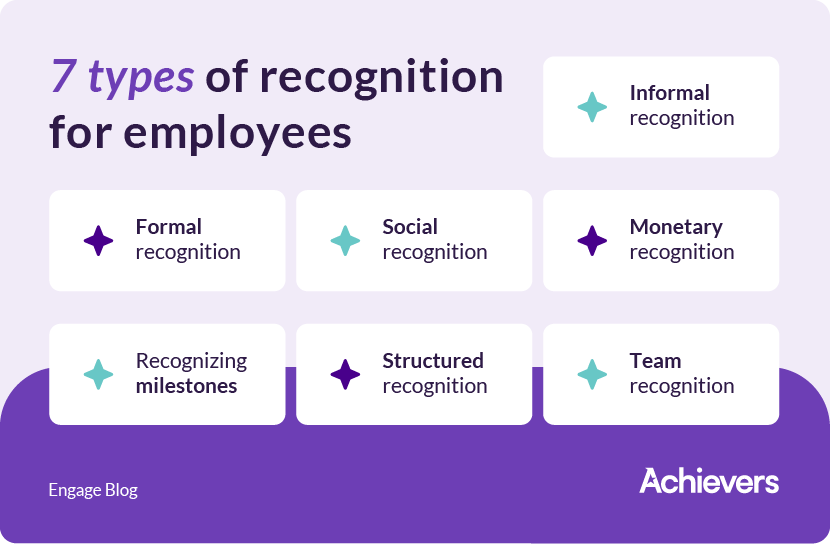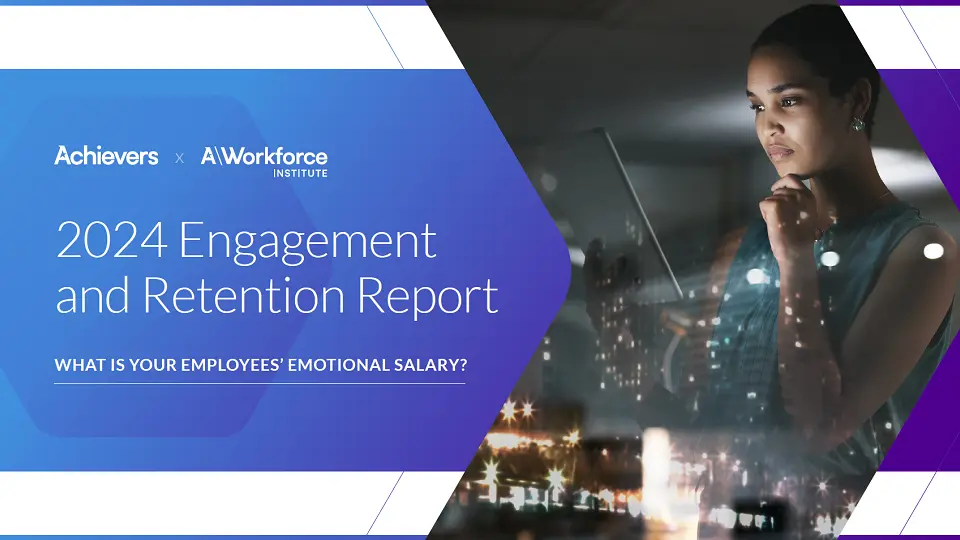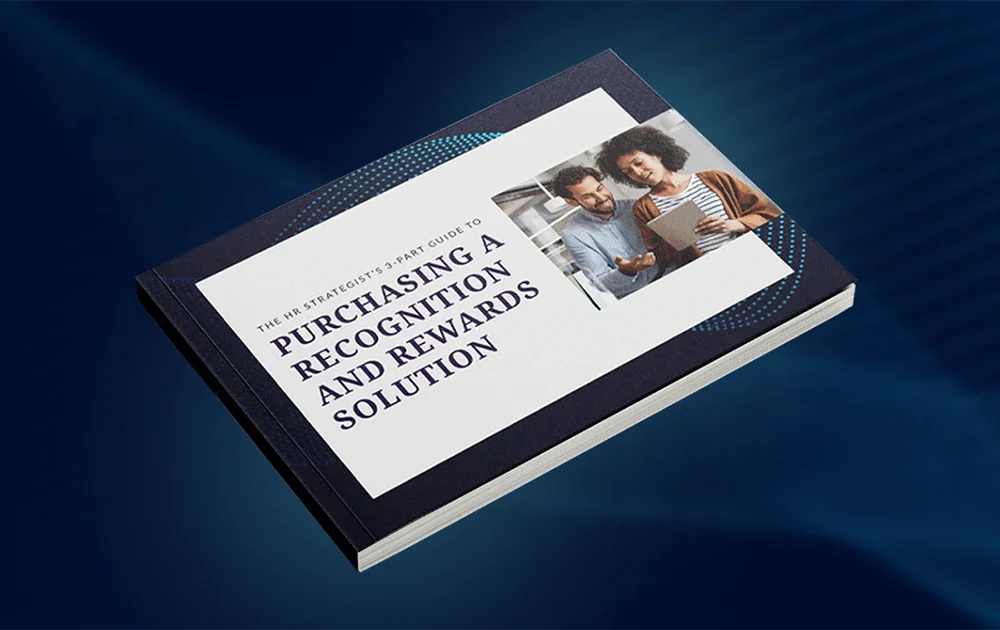Table of contents
Did you know there are multiple types of recognition? Gone are the days where the only recognition employees received was the occasional “attaboy” given in the hall after a meeting or a brief ceremony and plaque provided after every five years of service. Instead, today’s employees want — and expect — personalized recognition to be a part of their everyday experience on the job, whether they’re working remotely, in the office, or hybrid.
What is the most effective form of recognition?
The most effective form of recognition is direct feedback from managers or peers. When employees are recognized directly — whether verbally or in writing — it gives them a better sense of purpose at work and can lead to improved job performance, enhanced employee engagement, and even increased company revenue.
What type of recognition do employees value most?
The type of recognition employees value most can vary depending on the generation they belong to. For example, Baby Boomers and Gen Xers are less likely to require frequent recognition than Millennials and Gen Z. However, this doesn’t mean all generations don’t appreciate recognition. Older generations are typically more interested in being recognized for their career accomplishments or leadership skills, while younger generations tend to put a greater emphasis on collaboration, professional growth, and role-based achievements.

7 key types of employee recognition — with examples
Building a culture of recognition requires leveraging each and every type of recognition to the fullest. Here’s a brief rundown of seven major types of recognition your organization should incorporate into the employee experience.
1. Informal recognition
Informal recognition includes every form of appreciation that isn’t planned in advance by your organization. These small-scale instances of recognition add up and make the difference between a company where employees feel genuinely valued and one where recognition seems forced and insincere.
Just because recognition is informal doesn’t mean that your organization shouldn’t play a supportive role, of course. Empower employees to provide recognition whenever and wherever the mood strikes them with a mobile-friendly employee recognition solution. And provide awards for the top recognition receivers and givers at your company to keep the cycle of appreciation rolling.
Examples of informal recognition
- Verbal praise: Complimenting an employee or colleague in person or during a meeting.
- Private recognition: Taking a moment to have a one-on-one conversation to express thanks.
- Thank you notes: Writing a quick, personalized note or email to show appreciation.
- Public acknowledgment: Recognizing someone’s efforts in front of the team or in a group setting.
- Social media shout-outs: Highlighting someone’s achievements on social media platforms.
2. Formal recognition
Formal recognition encompasses many forms of appreciation that organizations have practiced for decades. While it is no longer enough on its own, it still plays an important role in any successful recognition program. You can think of formal recognition as the foundation your organization’s recognition program relies on. Without planning to recognize team members’ big moments and major successes, your other recognition initiatives will fall flat and so will morale.
In addition, formal recognition can serve as a benchmark for others to strive towards. When employees witness their colleagues being formally recognized for their accomplishments, it sets a standard for excellence and encourages others to demonstrate similar dedication and achievement. This healthy competition and aspiration for recognition can drive overall performance and productivity within the organization.
Examples of formal recognition
- Employee of the month/year awards: Regularly scheduled awards given to outstanding employees based on predefined criteria.
- Performance bonuses: Monetary rewards given based on performance evaluations or achieving specific targets.
- Promotion or title change: Elevating an employee to a higher position or changing their title to reflect their contributions.
- Formal commendations: Official letters or certificates of appreciation or recognition from senior management.
- Merit increases: Permanent salary increases based on performance reviews and achievements.
3. Social recognition
Social recognition is just as impactful as monetary recognition. Enabling social recognition at your organization requires providing employees with both the means and the motivation to show their appreciation to other team members frequently. The “means” part of the equation requires an employee recognition solution that allows employees to say thank you anytime, anywhere. It should also make saying thank you engaging with the ability to interact with others’ messages of recognition through comments, emojis, and gifs.
The motivation part requires your leaders to serve as examples for the rest of your organization to follow. Employees are far more likely to start practicing recognition when the most important figures at your organization demonstrate its importance to your company culture. Managers and other leaders should also ensure that they make communication with employees a two-way street. This encourages employees to provide both recognition and valuable constructive feedback to your company’s leadership team.
Examples of social recognition
- Peer-to-peer recognition programs: Platforms or systems where employees can recognize and thank each other.
- Recognition boards: Physical or digital boards where employees can post notes of appreciation for their peers.
- Employee spotlights: Featuring employees in newsletters, on the company intranet, or on the company website.
- Hashtags and campaigns: Using specific hashtags on social media to track and promote recognition efforts.
- Employee appreciation days/weeks: Specific days or weeks dedicated to showing appreciation for employees through special events, activities, or perks.
4. Monetary recognition
Rewarding employees provides them with tangible proof that your organization values them. Though monetary recognition is a more traditional incentive, a comprehensive reward and recognition program has to go beyond the standard to provide personalized rewards. Employees respond best to rewards they want, but individualizing rewards for each team member is nearly impossible.
That’s one of the reasons a points-based rewards system makes so much sense. With a points-based system, team members receive a set number of points through your company’s employee recognition platform every month or quarter. They can then spend these points on rewards that excite them from a catalog that should include items, experiences, and more from hundreds or even thousands of brands.
Examples of monetary recognition
- Performance bonuses: Additional compensation given for outstanding performance or achieving specific targets.
- Spot bonuses: Immediate, one-time bonuses awarded for exceptional work on a specific project or task.
- Profit sharing: Distributing a portion of the company’s profits among employees.
- Gift cards: Providing gift cards as a token of appreciation.
- Stock options or equity: Offering shares or stock options as part of the compensation package.
5. Milestone recognition
Milestone recognition in the workplace involves acknowledging and celebrating significant achievements, anniversaries, or milestones reached by employees or teams. Recognizing milestones is crucial because it shows employees that their dedication and contributions are valued and appreciated by the organization. It fosters a sense of belonging and loyalty among employees, strengthening their commitment to the company and its goals.
But to keep the tradition of milestone recognition fresh and engaging, companies will need to explore creative and unique ways to celebrate. This might involve incorporating personalized touches, such as handwritten notes or customized gifts, to make employees feel truly seen and appreciated. Another approach is to involve employees in the planning process, allowing them to contribute ideas and preferences for how they would like their milestones to be celebrated. By finding innovative ways to liven up this tradition, companies can ensure that milestone recognition remains meaningful, memorable, and impactful.
Examples of milestone recognition
- Service anniversary awards: Celebrating employees’ work anniversaries with awards or gifts.
- Project completion recognition: Acknowledging the successful completion of major projects.
- Promotion celebrations: Recognizing employees when they receive a promotion.
- Safety milestones: Recognizing periods of time without any workplace accidents or incidents.
- Onboarding completion: Celebrating the successful completion of the onboarding process for new employees.
6. Structured recognition
Structured recognition means having formal, organized methods in place to acknowledge and reward employees’ contributions, achievements, and milestones. This type of recognition is consistent and transparent, making sure everyone knows how they can be recognized and what achievements are celebrated by the organization.
When employees see that their efforts are formally acknowledged, it boosts their morale and job satisfaction. This isn’t just about feeling good; it translates into higher engagement, better productivity, and improved retention rates. Plus, structured recognition helps align individual performance with company goals, reinforcing the behaviors and achievements that matter most — a win-win for both employees and the organization.
Examples of structured recognition
- Annual performance reviews: Formal evaluations that include recognition for accomplishments and performance over the year.
- Incentive programs: Structured programs that offer financial or non-financial rewards for achieving specific objectives.
- Certification and training completion: Acknowledging employees who complete professional certifications or training programs.
- Sales achievement awards: Recognizing top sales performers with structured awards programs.
- Innovation awards: Structured programs that recognize employees for innovative ideas and solutions.
7. Team recognition
Team recognition in the workplace involves acknowledging and celebrating the collective achievements, efforts, and successes of teams or groups of employees. It’s about recognizing the collaborative work, synergy, and dedication that contribute to accomplishing shared goals and objectives.
By publicly acknowledging and appreciating the contributions of teams, organizations reinforce a culture of collaboration, teamwork, and shared accountability. This, in turn, can lead to higher levels of employee engagement, motivation, and satisfaction, as individuals feel valued and recognized for their collective efforts toward achieving common objectives. Team recognition also promotes a positive work environment where employees feel a sense of belonging and pride in their team’s accomplishments, ultimately contributing to overall organizational success and performance.
Examples of team recognition
- Team of the month/quarter: Regularly scheduled awards given to the most outstanding team based on performance and contributions.
- Team outings: Organizing team-building activities or outings as a reward for excellent performance.
- Recognition letters: Sending formal letters of recognition from senior management to the entire team.
- Customized gifts: Providing team-specific gifts that are meaningful and memorable.
- Professional development opportunities: Offering development opportunities as a reward for team success.
See the power of recognition in action
From social and monetary recognition, to milestone celebrations, to interactive recognition experiences — whatever you’re looking for in your recognition solution — it’s important to find a rewards and recognition provider that caters to your unique employee needs. After all, finding the right solution can transform how your team engages and celebrates with each other.
Enter Achievers Recognize, a mobile-friendly employee recognition platform that supports your team across multiple platforms, makes providing recognition an engaging experience, and includes a curated collection of global rewards from over 2,500 brands. Want to learn more? Try a free demo of Achievers Recognize and start building a culture of recognition at your organization today.
Find out what makes an online employee recognition platform effective.
Read the 2024 recognition report


